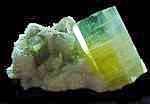
Mining Operations at Mount Mica & Orchard Pit Mines, Oxford County, Maine.
`
|
|
|
|
Mining Operations at Mount Mica & Orchard Pit Mines, Oxford County, Maine. |
|
Coromoto Minerals Mining
Operations at Mount Mica,
January 2008
Our approach in shooting these holes was to work a single row at a time. The pattern
Pocket 1 was found on January 8th. On the 11th, upon shooting (2) more holes in the next row and the remaining hole in the first row, exposed a pocket in the back wall. This pocket was perhaps an extension of pocket 1. Again, using the garden hose, we teased a large crystals, broken into many pieces, from the pocket debris. Frequently the cause for these fractured crystals are laid at the feet of the blasters. Though on occasion, and those are quite rare, blasting may damage a crystal, the blasters ,with justification, can plead innocence. Further, I don't believe the phenomenon referred to as 'pocket rupture' is the motive force in this destruction. Frequently a badly fractured tourmaline will be lying adjacent to a large and pristine quartz crystal. Quartz is notoriously easy to 'ding'. The cause(s) is, in my opinion, to found within the crystal itself. Most of these breaks lie on color boundaries. Perhaps differential growth rates or differing coefficients of expansion may be the cause.
So far each of these pockets seemed to house just one large crystal. This is in contrast to many We still had one row of holes left and the lowest hole from row 3. When these were done so would our mining season. I just couldn't coax Richard to endure the cold weather much longer. This row was just to the Once Mary arrived only a few probes at the crumbly feldspar followed by a couple of squirts from the garden hose made clear this space had something. We could soon see what appeared to be a large tourmaline resting in the soft cookeite sand of the pocket and covered by collapsed pieces from the pocket roof. We dared not hope that this crystal would be intact. We fully expected that the concealed part would be scores of broken pieces. Carefully, piece by piece, we removed the debris from around this rusty black tourmaline. As we did so, the sides continued to lengthen. Finally we could stand the suspense no longer. I grabbed the protruding end and extracted the tourmaline from where it had laid quietly for the last 300 million years. Upon seeing the crystal , pocket rapture took hold as we stared in amazement at the crystal. The 'black' tourmaline was in fact an complete elbaite crystal with a perfectly formed termination. Though we had found small crystals this well formed, nothing we had heretofore found approached the proportions of this one. Why did this crystal escape the destruction that was the lot of almost every other tourmaline we had found so far? My best guess is the near monochromatic makeup was the reason. In fact the crystal was found in two parts. The upper blue part had parted from the lower deep blue-black section right at the color change boundary. This crystal seems to have been a schorl that had grown into the pocket but had not undergone the multitude of color transitions of other tourmalines. In the pocket wall image above the root of this crystal can be seen as crumbly black schorl near the center of the image. Frank Perham, the 'god father' of Maine gem mining and a dear and respected friend of the mine, has uncanny ability to appear nearly at the very moment of each pocket discovery. For some reason he had gone MIA on this one. Still in the full glow of the discovery of this treasure, I called Frank and asked if I could bring it by his home to show it to him. When I got to his house it was a bright January afternoon. After a few microseconds of friendly chat, he asked to see the find. Handing him the crystal, he held it up to the daylight and in true Maine Yankee fashion allowed 'yes, that it was indeed a respectable specimen of tourmaline and just perhaps might rank amongst one of the finest in Mount Mica's history'. 'However', he went on to add, ' one might wish it to be a little more gemmy and perhaps.. more translucent... and...perhaps'. Relieving him of this imperfect load, a thought flashed from some dark supressed corner of my mind. What better final chapter to Frank's passion for finding tourmaline crystals could be conceived then be to bludgeoned to death with a giant tourmaline crystal :-). Frank, the quest for perfection continues...
|
|||||||||||